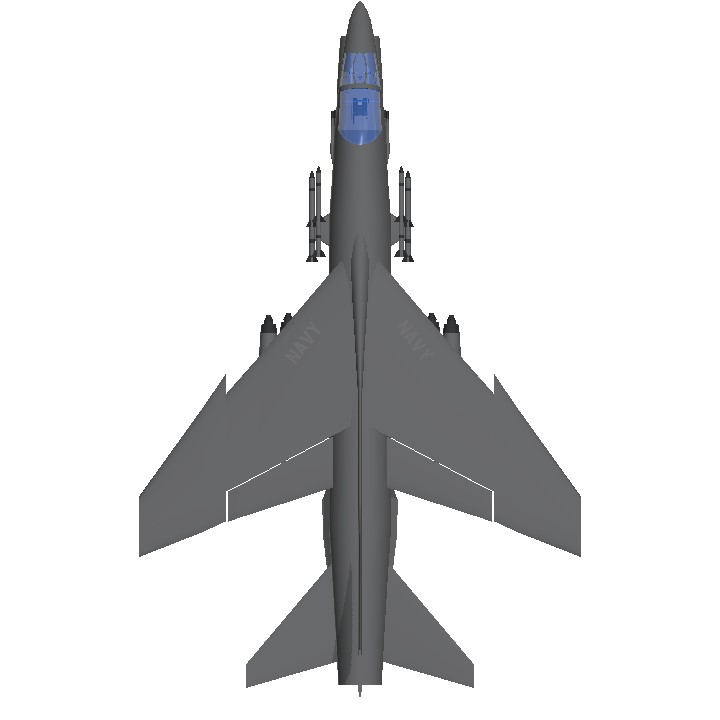The Last Gunfighter
Wikipedia
The Vought F-8 Crusader (originally F8U) is a single-engine, supersonic, carrier-based air superiority jet aircraft[2] built by Vought for the United States Navy and United States Marine Corps (replacing the Vought F7U Cutlass), and for the French Navy. The first F-8 prototype was ready for flight in February 1955. The F-8 served principally in the Vietnam War. The Crusader was the last American fighter with guns as the primary weapon, earning it the title "The Last of the Gunfighters".[3]
Design And Development
In September 1952, the United States Navy announced a requirement for a new fighter. It was to have a top speed of Mach 1.2 at 30,000 ft (9,144.0 m) with a climb rate of 25,000 ft/min (127.0 m/s), and a landing speed of no more than 100 mph (160 km/h).[4] Korean War experience had demonstrated that 0.50 inch (12.7 mm) machine guns were no longer sufficient and as a result the new fighter was to carry a 20 mm (0.79 in) cannon. 4x20 mm had become Navy standard prior to the Korean war: F2H, F9F, F3D and also the F7U and F4D, among others, preceded the F8U. In response, the Vought team led by John Russell Clark, created the V-383. Unusual for a fighter, the aircraft had a high-mounted wing which necessitated the use of a fuselage-mounted short and light landing gear. The major contribution to the short main gear, however, was the variable incidence wing that meant the plane did not take off and land extremely nose up, which was a characteristic of swept and low aspect ratio winged fighters.
The Crusader was powered by a Pratt and Whitney J57 turbojet engine. The engine was equipped with an afterburner which, on the initial production F8U-1 aircraft, increased the thrust of the engine from 10,200 lb to 16,000 lb, but, unlike later engines, had no intermediate thrust settings. The Crusader was the first jet fighter in US service to reach 1,000 mph; U.S. Navy pilot R.W. Windsor reached 1,015 mph on a flight in 1956.[5]
The most innovative aspect of the design was the variable-incidence wing which pivoted by 7° out of the fuselage on takeoff and landing (not to be confused with variable-sweep wing). This allowed a greater angle of attack, increasing lift without compromising forward visibility.[3][4] This innovation helped the F-8's development team win the Collier Trophy in 1956.[6] Simultaneously, the lift was augmented by leading-edge flaps drooping by 25° and inboard flaps extending to 30°. The rest of the aircraft took advantage of contemporary aerodynamic innovations with area-ruled fuselage, all-moving stabilators, dog-tooth notching at the wing folds for improved yaw stability, and liberal use of titanium in the airframe. The armament, as specified by the Navy, consisted primarily of four 20 mm (.79 in) autocannons; the Crusader happened to be the last U.S. fighter designed with guns as its primary weapon.[3] They were supplemented with a retractable tray with 32 unguided Mk 4/Mk 40 Folding-Fin Aerial Rocket (Mighty Mouse FFARs), and cheek pylons for two guided AIM-9 Sidewinder air-to-air missiles.[4] In practice, AIM-9 Sidewinder missiles were the F-8's primary weapon; the 20mm guns were "generally unreliable". Moreover, it achieved nearly all of its kills with Sidewinders.[7] Vought also presented a tactical reconnaissance version of the aircraft called the V-392.
Major competition came from the Grumman F-11 Tiger, the upgraded twin-engine McDonnell F3H Demon (which would eventually become the McDonnell Douglas F-4 Phantom II), and lastly, the North American F-100 Super Sabre hastily adapted to carrier use and dubbed the "Super Fury".
In May 1953, the Vought design was declared a winner and in June, Vought received an order for three XF8U-1 prototypes (after adoption of the unified designation system in September 1962, the F8U became the F-8). The first prototype flew on 25 March 1955 with John Konrad at the controls. The aircraft exceeded the speed of sound during its maiden flight.[3] The development was so trouble-free that the second prototype, along with the first production F8U-1, flew on the same day, 30 September 1955. On 4 April 1956, the F8U-1 performed its first catapult launch from Forrestal.
Operators
Real Life Operators
-United States Navy
-Philippines Navy
-France Navy
My Fictional Operators
-Serveredistan Airforce
Serve In Serveredistan
Serveredistan Is A Country Placed In Pacific
And Declared Their Independence in 1943.
in 1960 Serveredistan was the strongest air force in the Pacific due to the F-8K Crusader (Special Version For Serveredistan)
A total of 285 units were active in 1963 and all of them retired in 1997
The F-8K has been modified to be able to take off and land on damaged or primitive runways. The carrier's flight system has also been removed, such as the Catapult, and even the raised back system has also been removed.
Controls :
VTOL Down : Flaps
AG:
AG 1: Canopy
AG 2: Folding Wings
Specifications
Spotlights
- kanhnasgor 2.9 years ago
- Sakorsky 2.9 years ago
- MentallyDistorted 2.9 years ago
- TheCommentaryGuy 2.9 years ago
- HazerzIsBack 2.9 years ago
General Characteristics
- Predecessor F-8 Crusader
- Created On Android
- Wingspan 37.6ft (11.5m)
- Length 61.3ft (18.7m)
- Height 25.4ft (7.8m)
- Empty Weight N/A
- Loaded Weight 40,790lbs (18,502kg)
Performance
- Power/Weight Ratio 1.652
- Wing Loading 9.2lbs/ft2 (45.1kg/m2)
- Wing Area 4,417.9ft2 (410.4m2)
- Drag Points 10124
Parts
- Number of Parts 335
- Control Surfaces 7
- Performance Cost 1,765





Nice job, though you should probably add some tags...
GOOB BAY GUN FIGHTERS
Pretty stiff on maneuverability